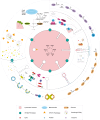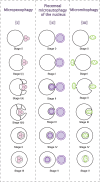Microautophagy: lesser-known self-eating
- PMID: 22080117
- PMCID: PMC11114512
- DOI: 10.1007/s00018-011-0865-5
Microautophagy: lesser-known self-eating
Abstract
Microautophagy, the non-selective lysosomal degradative process, involves direct engulfment of cytoplasmic cargo at a boundary membrane by autophagic tubes, which mediate both invagination and vesicle scission into the lumen. With its constitutive characteristics, microautophagy of soluble substrates can be induced by nitrogen starvation or rapamycin via regulatory signaling complex pathways. The maintenance of organellar size, membrane homeostasis, and cell survival under nitrogen restriction are the main functions of microautophagy. In addition, microautophagy is coordinated with and complements macroautophagy, chaperone-mediated autophagy, and other self-eating pathways. Three forms of selective microautophagy, including micropexophagy, piecemeal microautophagy of the nucleus, and micromitophagy, share common ground with microautophagy to some degree. As the accumulation of experimental data, the precise mechanisms that govern microautophagy are becoming more appreciated. Here, we review the microautophagic molecular machinery, its physiological functions, and relevance to human diseases, especially in diseases involving multivesicular bodies and multivesicular lysosomes.
Figures





References
-
- Klionsky DJ. Autophagy revisited: a conversation with Christian de Duve. Autophagy. 2008;4:740–743. - PubMed
Publication types
MeSH terms
LinkOut - more resources
Full Text Sources
Research Materials

